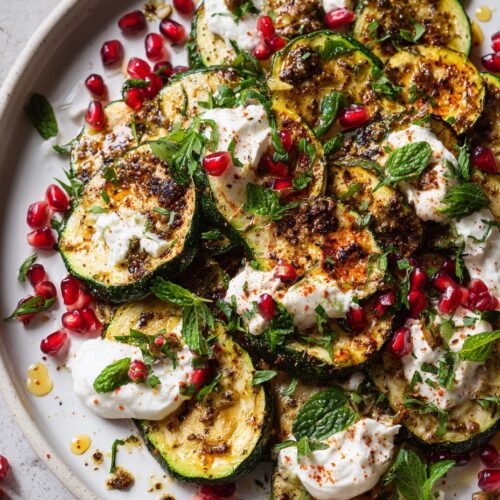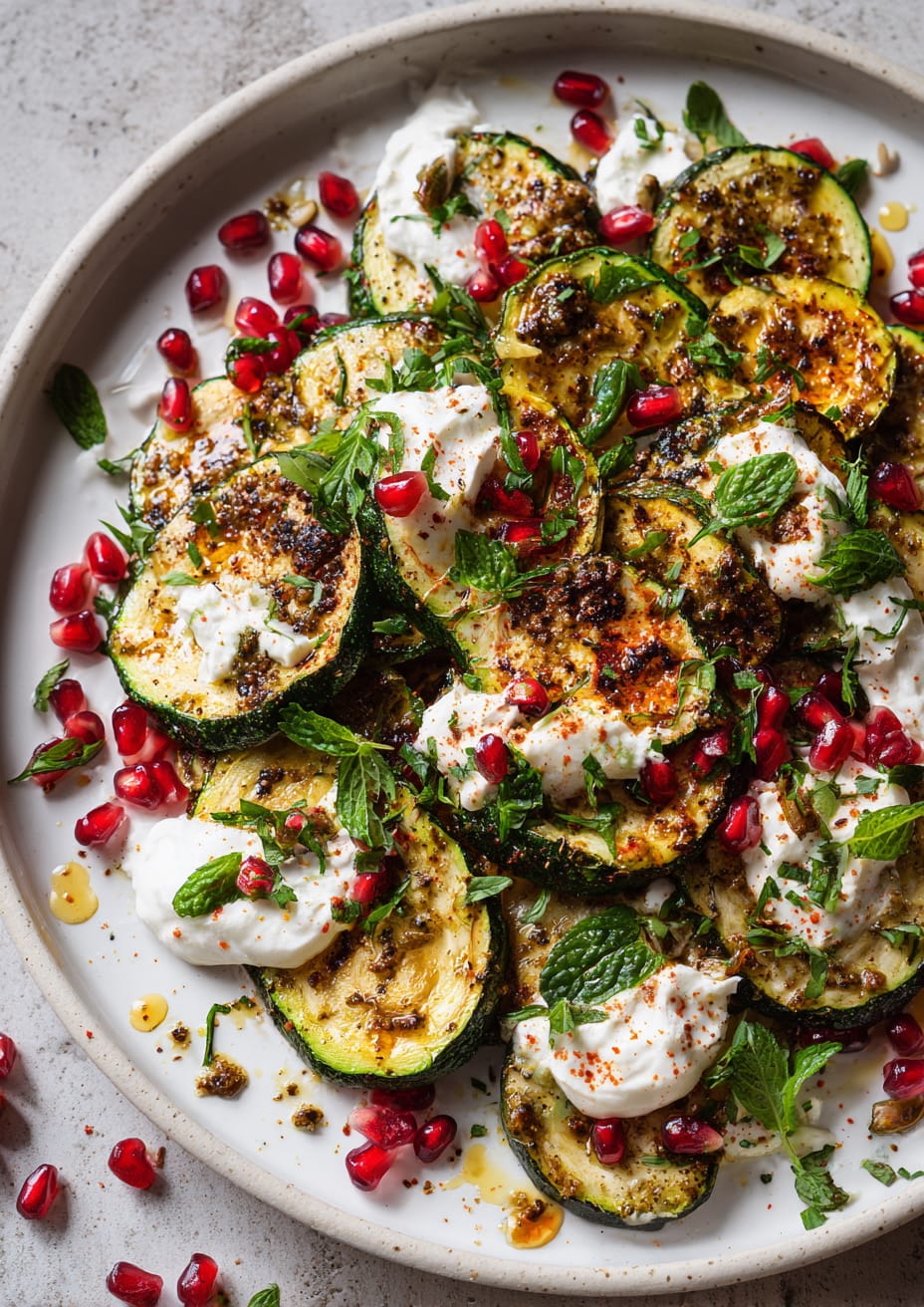I love pairing courgettes with za’atar and labneh
Some days I want a side dish that feels more than just “vegetables on the plate” — I want textures, contrasts, and flavours that make you pause for a second. That’s where this courgette, za’atar, and labneh combination comes in. It’s earthy from the za’atar, creamy from the labneh, and mellow-sweet from slow-roasted garlic.
Za’atar, with its blend of thyme, sesame seeds, and sumac, does something magical to courgettes. It adds warmth without heat, brightness without acidity. The labneh gives you a cool, tangy backdrop that keeps everything balanced. When you spoon the golden, herbed courgettes onto a generous smear of labneh and catch a bit of caramelised garlic in the same forkful — that’s the moment I know I’ve made the right side dish choice. Great as a mezze dish as well!
Ingredients you’ll need
This recipe works best with smaller courgettes, they hold their shape and get a nice char without turning watery. If you can get thick, full-fat labneh from a Middle Eastern grocer, it’ll make all the difference.
- 3–4 small courgettes (about 500g), cut into thick rounds
- 4 tbsp extra virgin olive oil, divided
- 1 whole head of garlic
- 1½ tbsp za’atar spice blend
- 200g labneh (or thick Greek yoghurt if unavailable)
- ½ tsp sea salt, plus more to taste
- Fresh parsley or coriander, for garnish
If you’ve never worked with labneh, it’s essentially strained yoghurt — denser, creamier, and more tangy than Greek yoghurt. It spreads like cream cheese but has a fresher flavour, making it brilliant for savoury dishes.
Step-by-step method for za’atar courgettes with labneh
I start by preheating the oven to 190°C. The garlic head gets the first treatment: I slice off the top to expose the cloves, drizzle with a tablespoon of olive oil, wrap it in foil, and pop it into the oven. It’ll take about 35–40 minutes to turn soft and caramelised.
While the garlic roasts, I toss the courgette rounds in a large bowl with the remaining olive oil, the za’atar, and sea salt. Once the garlic has about 20 minutes left, I spread the courgettes out on a separate tray and roast them until tender and lightly golden on the edges. By the time the garlic is done, the courgettes are perfectly cooked and fragrant.
To serve, I spread the labneh across a wide plate, pile the courgettes on top, and squeeze out some of the roasted garlic cloves here and there for pockets of sweet richness. A scattering of parsley or coriander finishes the plate.
Wine pairings for za’atar and labneh
Middle Eastern spices and creamy dairy can be tricky with wine, but I’ve found two styles that work beautifully. A crisp Assyrtiko from Greece offers citrus, salinity, and a mineral backbone that cuts through the richness of the labneh and balances the roasted courgettes. A Sauvignon Blanc from the Loire Valley also works well — its herbaceous notes echo the thyme in the za’atar.
If I’m leaning towards red, I go for a light, juicy Cinsault from Lebanon’s Bekaa Valley. It’s low in tannins and won’t overpower the delicate courgettes, while still giving you soft red fruit and gentle spice.
Beer pairings to try
For beer drinkers, a Belgian-style witbier is my top pick. The gentle coriander and citrus in the beer pair naturally with the sumac and thyme in the za’atar. Another great option is a light, crisp pilsner — refreshing, clean, and great at cutting through the creaminess of the labneh.
Both options keep the dish feeling fresh and avoid the heaviness that stronger, maltier beers might bring.
Frequently asked questions about this recipe
Can I use Greek yoghurt instead of labneh?
Yes — but strain it first to thicken it. Place it in a muslin-lined sieve over a bowl for a few hours in the fridge until it reaches a cream cheese-like texture.
Can I make this vegan?
Absolutely. Use a plant-based yoghurt alternative, strain it to thicken, and check that your za’atar blend doesn’t contain dairy (most don’t).
Can I grill the courgettes instead of roasting?
Yes — grilling adds a lovely smoky note. Just coat the courgettes in oil and za’atar as usual, then cook them on a hot grill until charred and tender.
Tips for success
Use good-quality za’atar — blends vary wildly in flavour. The sesame seeds should be fresh, not stale or bitter, and the thyme should still smell aromatic. When spreading the labneh, use the back of a spoon to create swirls — they’ll catch the olive oil and roasted garlic beautifully.
Warm spices meet creamy labneh here, but if you’re in the mood for more roasted flavours, my ratatouille-inspired roasted courgettes with tomatoes and herbs is a winner. For another herb-forward plate, try the charred courgettes with yoghurt, mint, and sumac.
Storage and reheating advice
The roasted courgettes will keep in an airtight container in the fridge for up to 3 days. They can be eaten cold or reheated in a frying pan over medium heat. Labneh should be stored separately and used within 5 days of opening.
Ingredient swaps for dietary needs
For a lower-fat version, use low-fat yoghurt instead of full-fat labneh. For nutty depth, sprinkle toasted pine nuts over the finished dish. To make it gluten-free, simply ensure your za’atar blend doesn’t contain wheat (some cheaper brands use it as a filler).
More recipes to explore
If you like Middle Eastern flavours, you’ll find more herb-rich courgette recipes that work for mezze spreads, summer barbecues, or casual weeknight dinners.

Courgettes with Za’atar, Roasted Garlic, and Labneh
Ingredients
- 4 Courgettes about 500g, cut into thick rounds
- 4 tbsp Olive oil extra virgin
- 1 head Garlic whole
- 1½ tbsp Za'atar
- 200 g Labneh or thick, full fat Greek yoghurt if unavailable
- ½ tsp Sea salt to taste
- 1 tbsp Fresh Parsley or coriander, chopped, for garnish
Instructions
- start by preheating the oven to 190°C. The garlic head gets the first treatment: slice off the top to expose the cloves, drizzle with a tablespoon of olive oil, wrap it in foil, and pop it into the oven. It’ll take about 35–40 minutes to turn soft and caramelised.
- While the garlic roasts, toss the courgette rounds in a large bowl with the remaining olive oil, the za’atar, and sea salt. Once the garlic has about 20 minutes left, spread the courgettes out on a separate tray and roast them until tender and lightly golden on the edges. By the time the garlic is done, the courgettes are perfectly cooked and fragrant.
- To serve, spread the labneh across a wide plate, pile the courgettes on top, and squeeze out some of the roasted garlic cloves here and there for pockets of sweet richness. A scattering of parsley or coriander finishes the plate.

